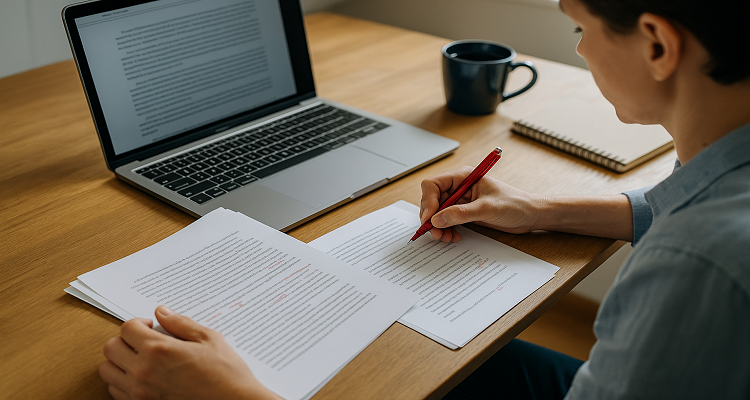
The Art of Self-Editing: How to Polish Your Writing Like a Pro
Let’s face it, first drafts are rarely brilliant. Even the most talented writers produce messy, imperfect drafts that need shaping, tightening, and refining. That’s where self-editing comes in.
Self-editing is the essential (and often overlooked) skill that transforms rough words into polished, publishable work. Whether you’re crafting a blog post, short story, article, or novel, learning to edit yourself will elevate your writing, boost your confidence, and impress readers and editors alike.
In this guide, you’ll learn a step-by-step system for self-editing your work effectively, efficiently, and without losing your mind.
1. Understand the Difference Between Drafting and Editing
✅ Drafting = creating content, exploring ideas, allowing mess
✅ Editing = shaping, refining, correcting, and polishing
Pro tip: Never try to draft and edit at the same time it slows you down and crushes creativity.
2. Take a Break Before Editing
After finishing a draft:
✅ Step away for a few hours (or days if possible)
✅ Let your brain reset
✅ Come back with fresh eyes
Pro tip: Distance helps you see flaws and gaps you missed while immersed in the work.
3. Read for Big Picture First
Start with structural issues, not commas.
Ask:
✅ Does the piece have a clear purpose and audience?
✅ Is the structure logical and easy to follow?
✅ Are there sections that drag or feel confusing?
✅ Is the opening strong and the conclusion satisfying?
Pro tip: Print out your work or change the font to trick your brain into seeing it as new.
4. Cut the Clutter
Great writing is lean.
✅ Eliminate redundant words or phrases
✅ Cut filler words: really, very, just, actually, basically
✅ Remove clichés and empty expressions
Example: Instead of “He was very angry,” write “He slammed his fist on the table.”
5. Strengthen Weak Sentences
✅ Replace vague language with precise details
✅ Use strong, active verbs
✅ Vary sentence length and rhythm
Example: Change “She went quickly to the store” to “She sprinted to the store.”
6. Check for Consistency
✅ Tone and style match throughout
✅ Characters or facts stay consistent
✅ Point of view doesn’t shift unexpectedly
✅ Formatting (headings, tense, etc.) is uniform
7. Read Aloud
Reading aloud reveals:
✅ Awkward phrasing
✅ Repetitive words
✅ Unnatural dialogue
✅ Missing or extra words
Pro tip: Use a text-to-speech tool for longer pieces.
8. Check Punctuation and Grammar
✅ Watch for common errors (their/there, it’s/its, affect/effect)
✅ Fix comma splices and run-on sentences
✅ Check quotation marks, apostrophes, and dashes
Pro tip: Use tools like Grammarly or ProWritingAid but don’t rely on them blindly.
9. Polish the Opening and Ending
✅ Make sure your opening grabs attention
✅ Ensure your ending leaves the reader satisfied
✅ Cut long wind-ups or trailing conclusions
Pro tip: Sometimes the strongest opening is buried in the second or third paragraph be willing to rearrange.
10. Get a Second Opinion
Even the best self-editors need feedback.
✅ Ask a trusted friend, writing group, or mentor
✅ Hire a professional editor if budget allows
✅ Use beta readers for longer works
Pro tip: Give your reviewer specific questions to guide their feedback.
Bonus: Develop Your Editing Checklist
✅ Purpose and audience clear
✅ Structure solid
✅ Clutter cut
✅ Strong, precise language
✅ Consistent tone and details
✅ Clean grammar and punctuation
✅ Engaging opening and ending
Pro tip: Create a checklist template to use for every project.
Common Self-Editing Mistakes to Avoid
❌ Editing too soon → finish the draft first
❌ Overediting → know when to stop
❌ Neglecting the big picture → fix structure before polishing sentences
❌ Ignoring your voice → stay true to your style
❌ Skipping professional help when needed
Sample Self-Editing Workflow
|
Step |
Action |
|
Break |
Step away for perspective |
|
Big Picture |
Check purpose, audience, structure |
|
Clutter |
Cut redundancies, filler, clichés |
|
Language |
Strengthen sentences, vary rhythm |
|
Consistency |
Check details, tone, formatting |
|
Read Aloud |
Listen for awkwardness |
|
Grammar Check |
Review mechanics and polish |
|
Feedback |
Get a second opinion |
Self-Editing Is a Superpower
Learning to edit yourself isn’t about nitpicking it’s about respecting your work and your reader.
With practice, you’ll develop an intuitive sense for:
- What works
- What doesn’t
- What your writing truly needs
So embrace editing not as a chore, but as a craft. It’s where your roughest drafts become your strongest work.
